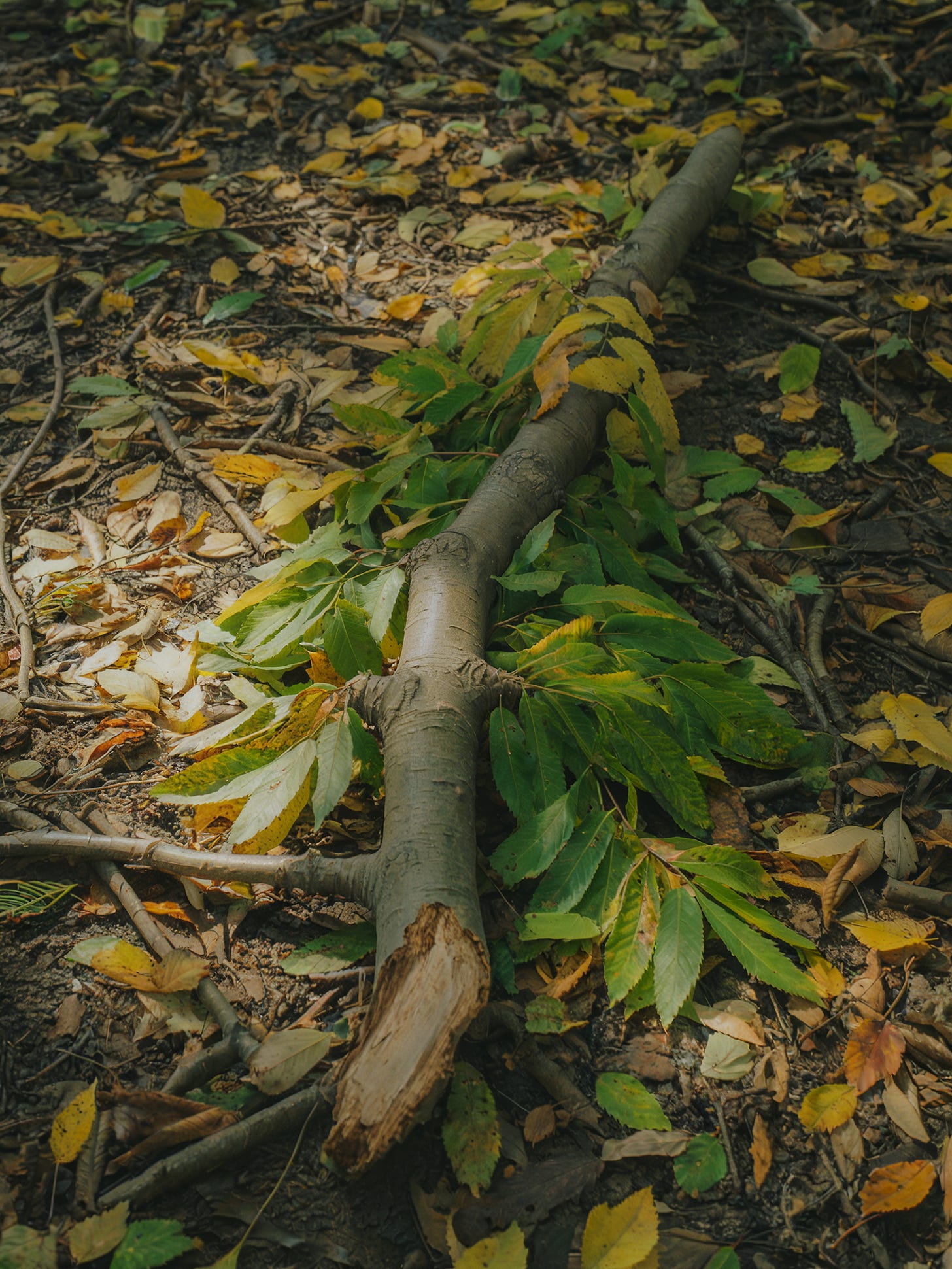The Difference Between Being In Nature and Being With Nature
Why spiritual practice with the Earth requires more than a hike or a view
Yesterday, while walking after a recent storm, I noticed several branches that had broken off a tree near my home. The sight stopped me. The air still carried the scent of rain, and the ground was soft beneath my feet.
Some branches lay shattered, leaves already wilting; others still clung to the tree, swaying slightly, resilient and alive. Standing there, I felt a wave of tenderness and perhaps unexpectedly, an awareness of my own mortality.
The tree reminded me that life both fragile and connected.
Its strength came not from isolation but from the network of roots intertwined with the trees around it. Even what was broken revealed the truth of community, how we hold one another up when the wind comes.
From Visiting Nature to Belonging with It
We often speak of getting into nature as though we were stepping outside of our ordinary lives, visiting a place apart. But we are never outside of it.
What if our spiritual hunger doesn’t come from distance, but from forgetfulness, from losing the felt sense that the living Earth has always held us, even in our most human moments of distraction?
Being in nature often means standing at a distance, taking in beauty as if it were a painting. We admire it, photograph it, seek its calm.
But being with nature invites reciprocity. It draws us into a living conversation, one that humbles and heals.
As I looked at that storm-struck tree, I realized that even the trees along an ordinary neighborhood street belong to a community of life unconcerned with our human dramas of politics or keeping up with the Joneses. They simply live, grow, and reach for the light together.
That, I thought, is the quiet wisdom the Earth keeps offering. Stability without competition, connection without noise.
Listening Instead of Looking
For much of my life, I’ve tried to understand nature through attention, naming species, identifying patterns, and analyzing systems. But the land keeps teaching me that the deeper invitation isn’t to observe, it’s to listen.
Listening begins when the mind softens its need to categorize. It’s when your body becomes the instrument of prayer, meditation, or contemplation.
When I slow down enough to listen, the world begins to respond. The wind shifts direction. A bird lands closer. A silence opens. It’s as if the landscape recognizes attention as a form of respect.
Yesterday, standing near that damaged tree, I sensed that it too was listening, to me, to the wind, to the other trees that had held it upright for so long.
The practice of being with nature isn’t passive. It’s a form of sacred attentiveness, one that includes noticing your own heartbeat as part of the forest’s rhythm.
Everyday Earth Mysticism
One of the teachings I emphasize in Rewilding the Soul is that we do not need to travel far to encounter the sacred.
The sacred is not reserved for untouched wilderness or distant pilgrimage routes. It’s alive in the places we overlook—the small stand of trees behind an office building, the weeds breaking through a sidewalk, the birds singing in a city courtyard.
These are the same places that keep reminding me that nature is not a destination but a relationship. Every time I think there’s nothing new to learn, I am surprised again—by a new scent after rain, by the resilience of a small plant reclaiming a crack in the pavement, by the patience of the more-than-human world that continues whether or not I’m paying attention.
Through this, I keep unlearning the habit of separation.
The Gift of Reciprocity
While I walk, I often whisper various mantras, such as “May I walk here with respect.”
It’s not a ritual in the formal sense. It’s an acknowledgment that I’m entering a living community, one that gives far more than it asks. That small act of permission changes the way I move. My pace slows. My eyes lift. My heart opens.
In this way, spiritual practice becomes relational rather than solitary. It’s not about mastering technique or seeking stillness—it’s about participating in the living exchange of attention between self and world.
Yesterday’s fallen branches reminded me that even brokenness participates in that exchange. The dead limbs return nutrients to the soil, feeding the roots that will send up new life next spring. Nothing is wasted. Nothing outside the circle.
A Closing Reflection
As autumn deepens, I think often about how the most vivid beauty we see, the brilliant reds and golds of fall, are carried by leaves that are dying. Even in their letting go, there is wonder and wisdom.
The land keeps teaching me that endings and beginnings are never separate. That presence, not permanence, is the measure of sacredness.
So as you step outside this week, pause for a moment before you begin to walk. Feel the ground beneath you. Touch a tree, or the natural side of a building warmed by sunlight. Whisper your gratitude to whatever greets you.
Walk not through nature, but with it.
You might just find that the Earth has been walking with you all along.
Thank you for reading Where Insight Meets Earth.
If this reflection resonates, share it with someone who longs to slow down and remember their belonging to the living world.
Subscribe for notifications future essays on eco-spirituality, contemplative walking, and embodied wisdom.



Yes! Agree.